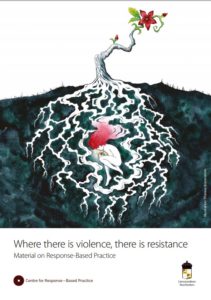Scenarios
The following content has been developed to support understanding of and responses to domestic and family violence.
The scenarios are developed by (i) organisations engaging with Insight Exchange and the ideas of response-based practice, or (ii) organisations (local and international) who are also working to understand, apply and share practices informed by response-based practice.
We invite you to draw from these examples to inform and evolve your good work.
Practice Exchange (Australia) – 5 scenarios and portfolio of reflections
Context: Practice Exchange was designed to be a supportive initiative for organisations to reflect on and develop their practice in responding to domestic and family violence and related forms of adversity. The collaboration centred on and drew from the work of Response-Based Practice.
5 scenarios (in PDF format only) are hosted inside the Practice Exchange 2019 Portfolio. Each service scenario is hypothetical and includes Scenario A and B as well as observations by Dr Allan Wade (Centre for Response-Based Practice).
Example #1 | A young woman with children is experiencing domestic and family violence. She has self-referred and this is her first face to face appointment with a staff member at the Domestic and Family Violence Specialist Service. (Page 12 - 20)
Example #2 | A young women talks with a Counsellor about her dad. (Page 27 - 31)
Example #3 | 'Samara' presented to the Emergency Department in a local health district. (Page 38 - 43)
Example #4 | Women’s Domestic Violence Court Advocacy Support receives a person’s details from the police. They are to make a phone call to the person and complete the Domestic Violence Safety Assessment Tool (DVSAT). They have a limited time frame. (Page 51 - 60)
Example #5 | A counselling client is 'ambivalent' about leaving her partner where there’s been a history of verbal, physical and emotional abuse - a few sessions in (Page 68 - 73)
Reflection:
All questions are leading in some form or another – like a flashlight in a dark room, they place attention somewhere, and take the conversation in a direction.
1. What do you notice about where the interviewer’s questions, even if short, take the person in this scenario?
2. And how does the person respond to the direction proposed by the interviewer?
Pedagogical Theatre (Sweden) – 3 scenarios (in video format) and supporting guide
Context: 'Collaboration Against Violence was a collaboration that started in 2012, between the municipalities in Norrbotten, the County Council of Norrbotten, the Police Authorities in Norrbotten and the Swedish prosecution Authority in Norrbotten. The aim of this collaboration was to provide support for individuals that had experienced violence and also offer support for the authorities in Norrbotten.'
The collaboration centred on and drew from the work of Response-Based Practice.
3 scenarios have been produced and are hosted on You Tube, each with version 1 and version 2 comparatively showing what response-based practice can look like when applied. The scenarios (below) can be played with English subtitles.
Eva being interviewed by a police officer.
Sarah being interviewed by a child protection social worker.
Eric being interviewed by a psychologist.
The supporting guide is in English and provides context and reflection questions about the scenarios.
We invite you to use these resources which are hosted on https://www.samverkanmotvald.se/una-norrbotten/responsed-based-practise/ and to evolve these in your good work.
The films and support material have been produced with the support of the County Administrative Board of Norrbotten and the Swedish Gender Equality Agency.
The Insight Exchange team would like to thank all the people involved in making this work possible and available to us all. Thankyou for your vision, generosity and dedication to work against violence and to work for safety, dignity and justice.


